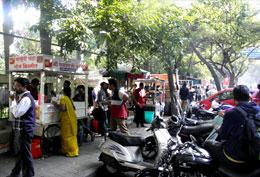India’s pulse rate soaring

Pulses, the common man’s food in India, is now beyond reach for millions in the sub-continent as prices soar triggering warnings of a food crisis that is likely to hit the Modi administration.
Indian media reported that the price of pulses, the main source of protein for the poor Indian masses, is much higher than the cost of chicken and has caused massive nationwide hoarding by unscrupulous retailers.
With India experiencing spiraling pulse-prices, the Associated Chambers of Commerce and Industry of India (Assocham) has called for close monitoring of food prices, warning that rice prices may soon reach "boiling point" with stocks falling fast as a fallout of deficient monsoon and drop in output.
"After pulses, onion and some edible oils like mustard oil, rice may cause pain-in-stomach of the consumers if timely adequate safeguards are not taken," Assocham's latest study said.
"Prices of rice may shoot up to reach a boiling point in the coming months as the stocks of the key staple cereal are depleting fast, owing to deficient rains and fall in output," Associated Chambers of Commerce and Industry of India (Assocham) said in a statement.
For Canadian farmers, especially in Saskatchewan, the dal crisis in India is paving the way for increased exports.
Canadian production of the eight major pulse and special crops (pea, lentil, bean, and chickpea) increased from about 1,000,000 tonnes in the early 1990s to 5.7 million tonnes in 2014.
Saskatchewan is at the heart of the Canadian pulse industry. With approximately 17,000 pulse growers and 95 special crop processors in Saskatchewan, the sector plays a significant role in the overall fortunes of the province’s agricultural industry. In 2014, Saskatchewan’s farmers grew 96 per cent of Canada’s lentil crop, 99 per cent of its chickpea crop, and 64 per cent of its dry pea crop.
The Indian government is scrambling to retrieve the situation because the rise in prices of pulses after coming under attack for not doing enough to control the spike in the costs of pulses and other food grain items, which made the life measurable for the poor and common men.
The increasing prices have hit restaurants and snack stalls across the country catering mainly to the office goers.
A food stall owner in Ghaziabad said that the cost of south Indian delicacies have been increased between Rs 10-20. As he reported that earlier he was charging a pair of Idlis with Sambar and Chutni Rs 20 and now he is charging Rs 30. Similarly, Dosas and Dal-vadas have seen a similar price hike.
Though India is the largest producer (18.5 million tones), it is also the largest consumer of pulses in the world and imports around 3.5 million tonnes annually on average to meet its ever-increasing consumption needs of around 22.0 million tonnes. Nearly a quarter of its demand is met through imports. As per the vision document of the Indian Institute of Pulses Research, the population of the country is expected to touch 1.68 billion by 2030 and the pulse requirement for 2030 is projected at 32 million tonnes with anticipated required annual growth rate of 4.2%.
Against this backdrop, the government swung into action with a number of measures to check price rise including use of price stabilisation fund and imports to cool prices and create a buffer stock but there is no foreseeable relief. New Delhi has imposed restrictions on holding of pulses stocks beyond a ceiling by licensed food processors, importers, exporters as well as large departmental retailers and taken action against hoarders and black-marketeers to contain prices by increasing availability via imports and urged consumers to wait for some time to see results.
Union minister Ravi Shankar Prasad commented, “There is a shortfall in production. To address the problem, the government is trying hard to boost supply through imports. The government is fully aware of the situation. Wait for some time.”
Prime minister Narendra Modi has appealed to the farmers of the country to grow more pulses in order to avoid imports and become self-sufficient in pulses production. The government should calibrate R&D efforts towards growing more crop and seed varieties in pulses that can enhance the food product.
Meanwhile, the United Nations Food and Agriculture Organization (FAO)
launched the International Year of Pulses 2016 (IYP) in Rome, Italy this month
Pulses—dry beans, dry peas, lentils and chickpeas—play an integral role in global food security, nutrition, human health and environmental sustainability, it said.
Gordon Bacon, CEO of Pulse Canada, said exports from Canada account for slightly more than one third of global pulse trade.
Canada is the world’s largest producer and exporter of dry peas and lentils, shipping to more than 150 countries around the world each year. In 2014, Canadian pulse exports were valued at over $3 billion CDN.
Canada’s biggest export markets are India, China and Turkey. Pulses are Canada’s fifth largest crop, after wheat, canola, corn and barley.









